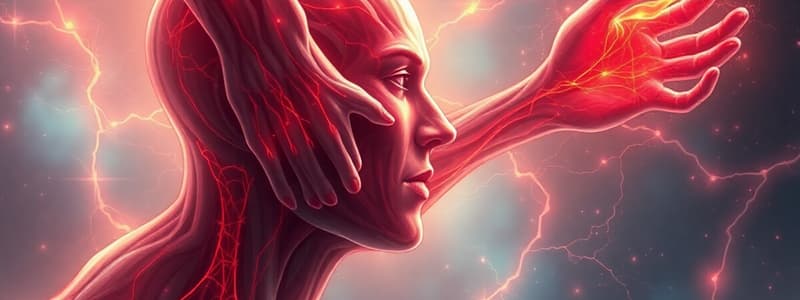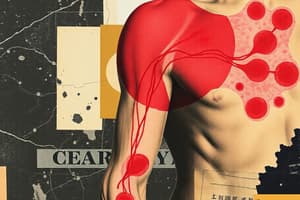Podcast
Questions and Answers
What characterizes primary weakness?
What characterizes primary weakness?
- Muscle literally has lost power leading to fatigue. (correct)
- Muscle shows normal power but has poor effort tolerance.
- Muscle preserves strength but involves pain.
- Muscle demonstrates symmetrical weakness across limbs.
Which of the following is a potential cause of distal weakness?
Which of the following is a potential cause of distal weakness?
- Hyperthyroidism
- Guillain Barre syndrome (correct)
- Vascular claudication
- Polymyalgia rheumatica
What is a common symptom observed in patients with Duchenne's Muscular Dystrophy?
What is a common symptom observed in patients with Duchenne's Muscular Dystrophy?
- Gait abnormalities and developmental delays. (correct)
- Difficulty with overhead tasks in the shoulder girdle.
- Symmetrical weakness in calves and feet.
- Central stenosis leading to spastic weakness.
What distinguishes asthenia from primary weakness?
What distinguishes asthenia from primary weakness?
In the context of spastic weakness, which artery's infarct is associated with upper limb and face paralysis?
In the context of spastic weakness, which artery's infarct is associated with upper limb and face paralysis?
Which condition is NOT commonly associated with proximal weakness?
Which condition is NOT commonly associated with proximal weakness?
Which symptom is indicative of anterior cerebral artery infarct?
Which symptom is indicative of anterior cerebral artery infarct?
How is Becker Muscular Dystrophy different from Duchenne's Muscular Dystrophy?
How is Becker Muscular Dystrophy different from Duchenne's Muscular Dystrophy?
What describes the weakness pattern seen with spinal or peripheral nerve involvement?
What describes the weakness pattern seen with spinal or peripheral nerve involvement?
What condition leads to pseudo instability in patients?
What condition leads to pseudo instability in patients?
What is a hallmark symptom of Guillain-Barre Syndrome?
What is a hallmark symptom of Guillain-Barre Syndrome?
What is the primary cause of weakness in Dermatomyositis?
What is the primary cause of weakness in Dermatomyositis?
Which symptom is typically associated with Myasthenia Gravis?
Which symptom is typically associated with Myasthenia Gravis?
What is the typical mean age of onset for Motor Neuron Disease?
What is the typical mean age of onset for Motor Neuron Disease?
In Bell's Palsy, what is a common sign observed?
In Bell's Palsy, what is a common sign observed?
What common outcome can be expected in patients with Guillain-Barre Syndrome?
What common outcome can be expected in patients with Guillain-Barre Syndrome?
Which muscle weakness pattern is most common in Inflammatory Myopathies?
Which muscle weakness pattern is most common in Inflammatory Myopathies?
What treatment option is commonly used for Myasthenia Gravis?
What treatment option is commonly used for Myasthenia Gravis?
What is one possible sign observed in patients with advanced stages of Motor Neuron Disease?
What is one possible sign observed in patients with advanced stages of Motor Neuron Disease?
Which of the following conditions is characterized by a significant fatigueable weakness that typically starts with the ocular muscles?
Which of the following conditions is characterized by a significant fatigueable weakness that typically starts with the ocular muscles?
Which condition involves acute inflammatory demyelinating polyradiculoneuropathy?
Which condition involves acute inflammatory demyelinating polyradiculoneuropathy?
What is often the first location for muscle weakness in Guillain-Barre Syndrome?
What is often the first location for muscle weakness in Guillain-Barre Syndrome?
What is one possible side effect of the treatment for Bell's Palsy?
What is one possible side effect of the treatment for Bell's Palsy?
Which type of myopathy is characterized largely by chronic, proximal muscle weakness due to endocrine disorders?
Which type of myopathy is characterized largely by chronic, proximal muscle weakness due to endocrine disorders?
Flashcards
Primary Weakness
Primary Weakness
Weakness where the muscle literally has lost power or cannot do its task. It fatigues out earlier compared to other muscles.
Asthenia
Asthenia
Weakness with normal muscle power symmetrically, but weaker than expected due to deconditioning. Patients may experience a disproportionate level of fatigue and exhaustion for tasks.
Asymmetrical Weakness
Asymmetrical Weakness
Weakness affecting specific muscles or muscle groups on one side of the body. May be caused by spinal or peripheral nerve issues.
Symmetrical Weakness
Symmetrical Weakness
Signup and view all the flashcards
Proximal Weakness
Proximal Weakness
Signup and view all the flashcards
Distal Weakness
Distal Weakness
Signup and view all the flashcards
Muscular Dystrophy
Muscular Dystrophy
Signup and view all the flashcards
Duchenne Muscular Dystrophy
Duchenne Muscular Dystrophy
Signup and view all the flashcards
Becker Muscular Dystrophy
Becker Muscular Dystrophy
Signup and view all the flashcards
Gower's Sign
Gower's Sign
Signup and view all the flashcards
What are Myopathies?
What are Myopathies?
Signup and view all the flashcards
What is Dermatomyositis?
What is Dermatomyositis?
Signup and view all the flashcards
What are Endocrine Myopathies?
What are Endocrine Myopathies?
Signup and view all the flashcards
What is Motor Neuron Disease?
What is Motor Neuron Disease?
Signup and view all the flashcards
What is Guillain-Barré Syndrome?
What is Guillain-Barré Syndrome?
Signup and view all the flashcards
What is Bell's Palsy?
What is Bell's Palsy?
Signup and view all the flashcards
What are the key characteristics of Motor Neuron Disease?
What are the key characteristics of Motor Neuron Disease?
Signup and view all the flashcards
How does weakness manifest in Motor Neuron Disease?
How does weakness manifest in Motor Neuron Disease?
Signup and view all the flashcards
What are the symptoms of Motor Neuron Disease?
What are the symptoms of Motor Neuron Disease?
Signup and view all the flashcards
What are fasciculations?
What are fasciculations?
Signup and view all the flashcards
How does weakness manifest in Guillain-Barré Syndrome?
How does weakness manifest in Guillain-Barré Syndrome?
Signup and view all the flashcards
What is Paraesthesia in Guillain-Barré Syndrome?
What is Paraesthesia in Guillain-Barré Syndrome?
Signup and view all the flashcards
What is Fatigueable Weakness?
What is Fatigueable Weakness?
Signup and view all the flashcards
What is Ptosis?
What is Ptosis?
Signup and view all the flashcards
What is Pronator Drift?
What is Pronator Drift?
Signup and view all the flashcards
Study Notes
Types of Weakness
-
Primary Weakness: Muscle loses power or cannot perform tasks. Fatigues quickly compared to other muscles. Potential underlying causes include muscle damage, disruptions in nerve signals, and problems with muscle impulses.
-
Asthenia: Muscles have normal strength but reduced tolerance. Even minor tasks lead to significant fatigue, and the patient experiences longer recovery times than expected, particularly for exercise and daily activities (ADLs).
-
Pseudo Instability: A feeling of joint instability without actual giving way. Occurs when muscles are painful or not firing correctly, often seen in the hip or knee.
Patterns of Weakness
-
Spinal/Peripheral Nerve Weakness: Asymmetrical weakness impacting specific muscle groups is common. Reflex changes and corresponding pain/paraesthesia in the affected skin area are often present. Can be caused by inciting events like disc herniation, lateral stenosis, or entrapment.
-
Symmetrical Weakness (Limbs): Weakness affecting both limbs, often developing gradually. Possible causes include spinal or vascular system issues, like central stenosis, spinal infection, or peripheral arterial disease (stage 2).
-
Proximal Weakness (Shoulder/Hip Girdle): Difficulty with overhead tasks, standing, and stair climbing. Avoidance of these actions may seem like weakness, but underlying causes like dermatomyositis, hyperthyroidism, or polymyalgia rheumatica (often pain-related) may be the issue. Myasthenia gravis can also manifest here, starting from eyes/head and spreading outwards.
-
Distal Weakness (Hands/Feet): Subtle changes like reduced finger dexterity, grip strength loss, toe/heel drop are common. This can result from central stenosis, diabetes, vitamin B deficiencies, motor neuron disease, or Guillain-Barre syndrome.
-
Middle Cerebral Artery (MCA) Weakness: Upper limb and facial weakness, potentially with spasticity/paralysis. The forehead is typically spared on the face, with numbness/paraesthesia in the corresponding area. Speech issues (Wernicke's aphasia) can accompany these symptoms.
-
Anterior Cerebral Artery (ACA) Weakness: Whole leg weakness, typically spastic and accompanied by numbness/paraesthesia. Potential for urinary/bowel issues (incontinence) are possible, along with Broca's aphasia (difficulty expressing speech).
Muscular Dystrophy
-
Muscle Dystrophies: A group of inherited disorders that cause progressive muscle weakness and atrophy, due to genetic defects impacting muscle function.
-
Duchenne Muscular Dystrophy (DMD): Most common type; affects males (1:3500). Early development may be normal or high-functioning. Shows developmental delays (1-3 years), gait problems, Gower's sign, cognitive issues. Muscle degeneration and necrosis are evident; muscle is replaced by fat (pseudohypertrophy). Usually diagnosed between 3-5 years old; typically wheelchair-bound by 7-13 years old. Reduced lifespan (around 30 years) from cardiopulmonary issues. Elevated serum CPK (creatine phosphokinase) level is a key blood test finding.
-
Becker Muscular Dystrophy (BMD): Onset is later and symptoms are milder than DMD. Patients tend to walk longer (into their teens and beyond in some cases) though ambulation challenges are present. Mental impairment is less common. Heart problems are less common but are more severe when present, compared to DMD.
Inflammatory/Endocrine Myopathies
-
Inflammatory Myopathies: (covered more thoroughly in CM1) Include conditions like Dermatomyositis, characterized by primary, bilateral proximal muscle weakness, skin rashes (rash on hands/face), and a possible history of breast cancer.
-
Endocrine Myopathies: (covered more thoroughly in CM1) Cause chronic and proximal muscle weakness. Muscle weakness can be resolved by addressing the underlying endocrine problem. Possible causes include pituitary disorders (acromegaly), hyperthyroidism, hyperparathyroidism (and resultant osteomalacia), and adrenal issues (Cushing's or Addison's disease).
Motor Neuron Disease (ALS)
-
Motor Neuron Disease (ALS): Also known as amyotrophic lateral sclerosis. The most frequent degenerative motor system disease. Characterized by the progressive deterioration of both upper and lower motor neurons, resulting in gradual, painless, widespread weakness. Onset usually in late 50s. Reduced lifespan.
-
Symptoms & Signs: Initial signs may involve reduced finger dexterity or intrinsic hand muscle wasting, muscle cramping, stiffness, weakness. Potential for wrist drop, stumbling/tripping, awkward running. Foot drop, and slapping gait patterns can manifest. Speech and swallowing difficulties (bulbar/pseudobulbar features) may also be present. Fasciculations (twitching muscles) are possible, particularly in the tongue and limbs. Muscle atrophy, spasticity, hyperreflexia (or hyporeflexia as both LMN & UMN are involved) are common. Sensory, bowel, bladder, or sexual dysfunction is not expected with ALS. Cognitive impairment may be seen in later stages.
Guillain-Barre Syndrome
- Guillain-Barre Syndrome: An acute immune-mediated demyelinating polyradiculoneuropathy with hallmark progressive weakness over days to weeks, starting from the lower extremities and moving upwards. Usually develops 2-4 weeks after a mild respiratory or gastrointestinal illness. Sometimes, proximal muscle areas (like hip flexion) are first affected. Glove and stocking sensory distribution/pain, and/or aching can occur. Cranial nerve issues (dysphagia, dysarthria, diplopia, pupillary problems, facial droop) are also possible. Respiratory compromise (dyspnea to respiratory failure) is a significant concern. Testing is done with EMG and nerve conduction studies. Immunomodulatory treatment (IVIG and plasma exchange), including supportive ventilation if required, is important.
Bell's Palsy
- Bell's Palsy: Acute facial paralysis (usually unilateral). Peak effect within 48 hours. Possible causes include swelling of the facial nerve, uncertain etiology. Symptoms range from mild numbness to full paralysis, with pain around the ipsilateral mastoid process. Facial nerve palsy is evident (ipsilateral paralysis of the entire face, including the brow), with possible taste/salivation impairment or hyperacusis (clapping response). Reduced tear production is also sometimes observed. Patients experience Bell's Phenomenon – inability to fully close affected eye, and eye rotates up and out) when attempting to close eyes and show teeth. Treatment includes eye protection, high-dose corticosteroids, and antiviral therapy. Recovery is usual (80% spontaneously recovery, but with possible residual facial asymmetry).
Myasthenia Gravis
- Myasthenia Gravis (MG): A rare autoimmune disease that affects acetylcholine receptors at the neuromuscular junction. Results in fatigable muscle weakness, usually starting in the proximal muscles, such as the eyes (ptosis). Weakness can spread to the rest of the body if not managed. Diagnosed by looking for fatigable strength with repeated movements. Eye problems, difficulty in pursuing, pronouncing or pronating movements, and pronator drift are common indications and should be looked into.
Studying That Suits You
Use AI to generate personalized quizzes and flashcards to suit your learning preferences.




